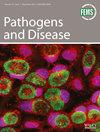Homology, disruption and phenotypic analysis of CaGS Candida albicans gene induced during macrophage infection
引用次数: 11
Abstract
During macrophage infection Candida albicans expresses differentially several genes whose functions are associated with its survival strategy. Among others, we have isolated CaGS gene, which is homologous to SNF3, a glucose sensor of Saccharomyces cerevisiae. To elucidate its potential role during infection, CaGS has been disrupted and the resulting phenotype analyzed on different solid media. The null mutant lost the ability to form hyphae on a medium with low glucose concentration and serum. Furthermore, this mutant does not disrupt macrophage in in vitro infections. We believe that this putative glucose sensor is involved in hyphal development during macrophage infection.
巨噬细胞感染诱导白色念珠菌基因cag的同源性、破坏及表型分析
在巨噬细胞感染过程中,白色念珠菌表达了几个与其生存策略相关的基因。其中,我们分离到了CaGS基因,该基因与酿酒酵母的葡萄糖传感器SNF3同源。为了阐明其在感染过程中的潜在作用,研究人员破坏了cag,并在不同的固体培养基上分析了其表型。零突变体在低葡萄糖浓度和血清培养基中失去了形成菌丝的能力。此外,该突变体在体外感染中不会破坏巨噬细胞。我们认为这种假定的葡萄糖传感器参与了巨噬细胞感染期间菌丝的发育。
本文章由计算机程序翻译,如有差异,请以英文原文为准。
求助全文
约1分钟内获得全文
求助全文

 求助内容:
求助内容: 应助结果提醒方式:
应助结果提醒方式:


